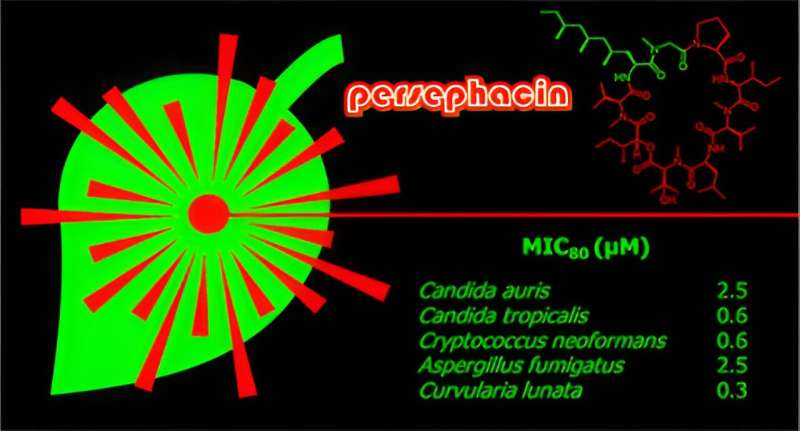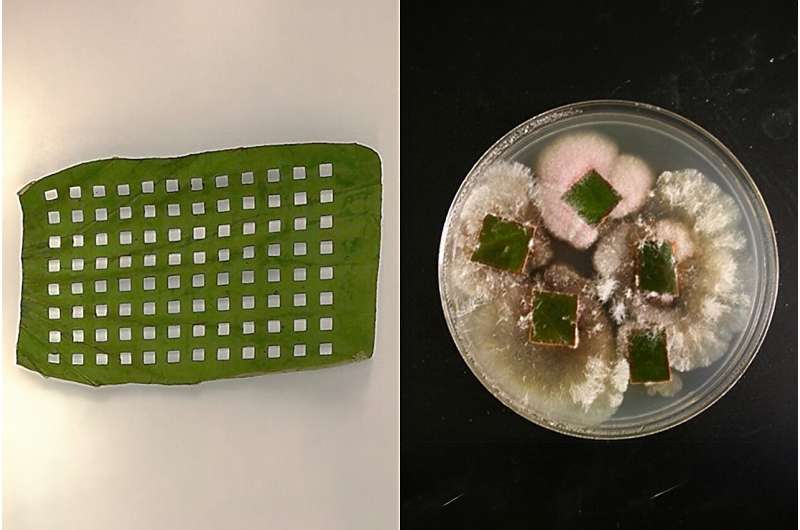This article has been reviewed according to Science X's editorial process and policies. Editors have highlighted the following attributes while ensuring the content's credibility:
fact-checked
peer-reviewed publication
trusted source
proofread
Researchers discover antifungal molecule

Fungal infections are killing thousands of Americans each year, some with a morbidity rate of nearly 80%. To make matters worse, only a handful of antifungal treatments are available, and even those are becoming less effective as fungi become more resistant. However, University of Oklahoma researchers have recently published findings in the Journal of Natural Products indicating that a novel breakthrough treatment may have been discovered.
"The molecule we're excited about is called persephacin," said Robert Cichewicz, Ph.D., principal investigator and Regents Professor in the Department of Chemistry and Biochemistry, Dodge Family College of Arts and Sciences at OU. "This antifungal discovery appears to work on a broad spectrum of infectious fungi, and it is reasonably non-toxic to human cells, which is a huge deal because many current treatments are toxic to the human body."
The rise in fungal infections is due, in part, to the successful treatment of other diseases. As people live longer and successfully undergo treatments like chemotherapy and organ transplants, they often live with weakened immune systems. When drugs that treat arthritis and other ailments that also weaken immune systems are added to the mix, a perfect storm is created for potentially deadly fungal infections.
Cichewicz, who has been researching fungi for nearly 20 years, leads the Natural Products Discovery Group at OU. This team of researchers discovered this novel molecule and developed a unique method for testing plants for their antifungal properties.

"Fungi are found throughout the botanical world, and plants and fungi often work together. Some of these fungi kill competitors or deter insects from eating the plant," Cichewicz said. "We hypothesized that if these plant-dwelling fungi, known as endophytes, could help the plants fight off infections by killing the invading fungi, then these molecules might also be able to protect humans and animals from fungal pathogens. As it turns out, we were right."
The team developed a novel way to procure leaf samples using a laser device called the Fast Laser-Enabled Endophyte Trapper, or FLEET. This method helps generate samples in a sterile environment and drastically increases the number of samples that can be acquired.
"Using traditional methods, we could process roughly four to six samples per minute," Cichewicz said. "But our FLEET system is capable of aseptically generating between 500-600 tissue specimens in 10 minutes. This allows us to rapidly screen more samples and enhances the opportunity for potential drug discoveries."
With assistance from the Office of Technology Commercialization at the University of Oklahoma, Cichewicz was awarded a U.S. patent for using persephacin to control infectious pathogens.
"It's taken us a long time to get to this point, but now we're hoping to work with an industry partner to help us develop this treatment," Cichewicz said. "Antifungal resistance keeps evolving, and this could provide a new alternative. That's why this molecule is so exciting."
More information: Lin Du et al, Persephacin Is a Broad-Spectrum Antifungal Aureobasidin Metabolite That Overcomes Intrinsic Resistance in Aspergillus fumigatus, Journal of Natural Products (2023). DOI: 10.1021/acs.jnatprod.3c00382
Journal information: Journal of Natural Products
Provided by University of Oklahoma





















